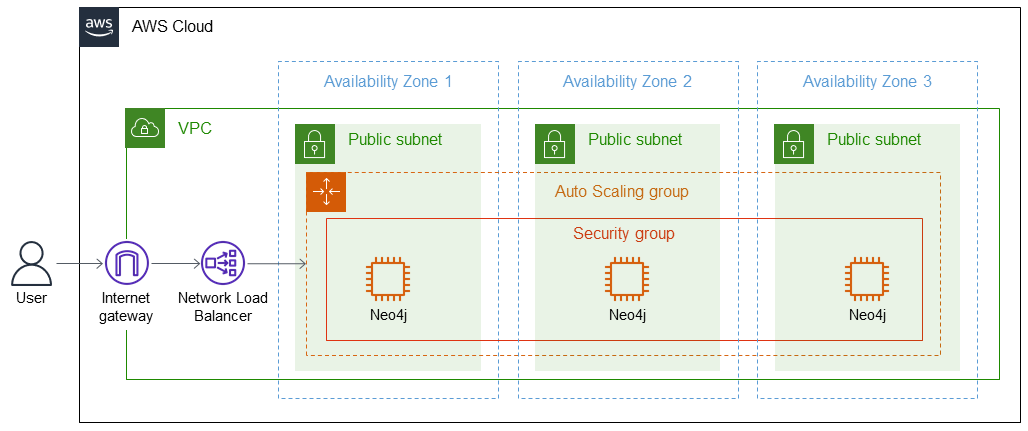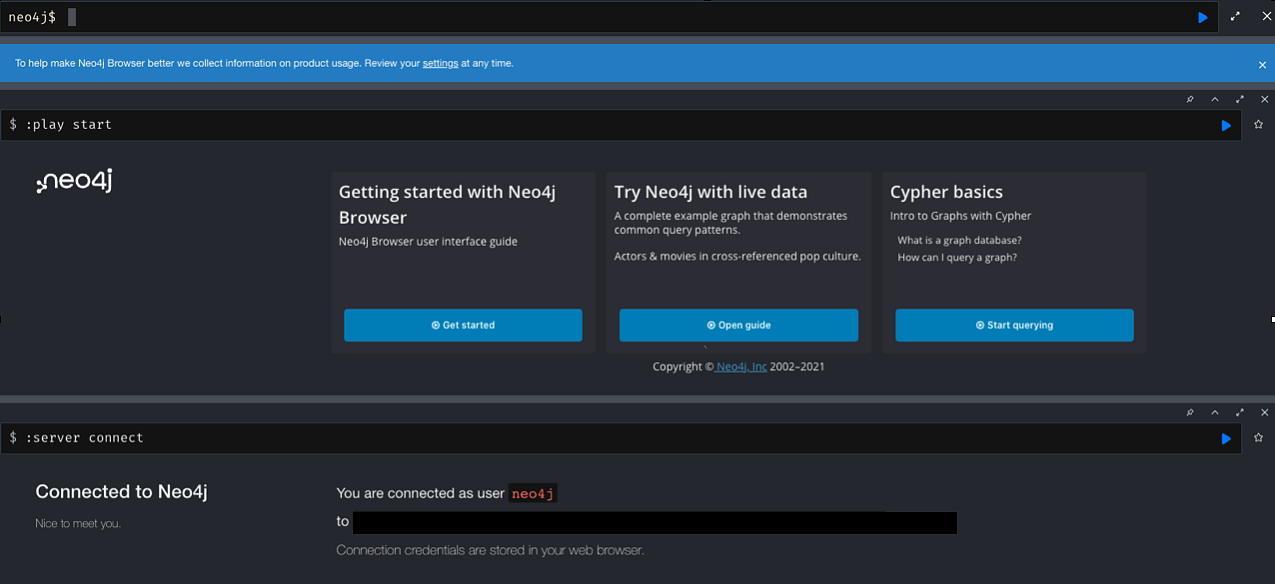Neo4j Enterprise Edition on AWS
Partner Solution Deployment Guide

January 2023
Ed Randall, Harshit Singhvi, Oliver Hughes, Bledi Feshti, Ben Lackey, Neo4j
Antony Prasad, AWS Data & Analytics Partner team
Battulga Purevragchaa, Suresh Veeragoni, AWS Workload Migration Program

| Refer to the GitHub repository to view source files, report bugs, submit feature ideas, and post feedback about this Partner Solution. To comment on the documentation, refer to Feedback. |
This Partner Solution was created by Neo4j in collaboration with Amazon Web Services (AWS). Partner Solutions are automated reference deployments that help people deploy popular technologies on AWS according to AWS best practices. If you’re unfamiliar with AWS Partner Solutions, refer to the AWS Partner Solution General Information Guide.
Overview
This Partner Solution deploys Neo4j Enterprise Edition on the AWS Cloud. If you are unfamiliar with AWS Partner Solutions, refer to the AWS Partner Solutions General Information Guide.
Costs and licenses
This Partner Solution requires a license for Neo4j. To use the Partner Solution in your production environment, sign up for a license at Neo4j Licensing. For information about the trial license, refer to the Neo4j Evaluation Agreement for Neo4j Software.
There is no cost to use this Partner Solution, but you will be billed for the resources deployed. For more information, refer to the AWS Partner Solutions General Information Guide.
Architecture
| This Partner Solution does not support shared subnets. |
Deploying this Partner Solution with default parameters builds the following Neo4j environment in the AWS Cloud.

As shown in Figure 1, the Partner Solution sets up the following:
-
A highly available architecture that spans three Availability Zones in your default virtual private cloud (VPC).
-
An internet gateway to allow the VPC to connect to the internet.
-
A Network Load Balancer to route traffic to the Neo4j instances in the public subnets.
-
In the public subnets, Neo4j deployed to Amazon Elastic Compute Cloud (Amazon EC2) instances in an Auto Scaling group. You can deploy a single instance or an autonomous cluster of 3–10 instances (three shown).*
-
A security group to control access to the Neo4j instances.
* By default, to give users a better experience when getting started with Neo4j, this Partner Solution deploys in a public subnet. If you’re deploying this Partner Solution in a production environment, consider using a private subnet. A private subnet limits how you access the Neo4j application and Neo4j browser over the public internet. For more information, refer to Connect your VPC to other networks.
Deployment options
This Partner Solution provides the following deployment option to provision Neo4j into your default VPC:
The deployment uses one template that contains configuration parameters that you can customize.
Deployment steps
-
Sign in to your AWS account, and launch this Partner Solution, as described under Deployment options. The AWS CloudFormation console opens with a prepopulated template.
-
Choose the correct AWS Region, and then choose Next.
-
On the Create stack page, keep the default setting for the template URL, and then choose Next.
-
On the Specify stack details page, change the stack name if needed. Review the parameters for the template. Provide values for the parameters that require input. For all other parameters, review the default settings and customize them as necessary. When you finish reviewing and customizing the parameters, choose Next.
Unless you’re customizing the Partner Solution templates or are instructed otherwise in this guide’s Predeployment section, don’t change the default settings for the following parameters: QSS3BucketName,QSS3BucketRegion, andQSS3KeyPrefix. Changing the values of these parameters will modify code references that point to the Amazon Simple Storage Service (Amazon S3) bucket name and key prefix. For more information, refer to the AWS Partner Solutions Contributor’s Guide. -
On the Configure stack options page, you can specify tags (key-value pairs) for resources in your stack and set advanced options. When you finish, choose Next.
-
On the Review page, review and confirm the template settings. Under Capabilities, select all of the check boxes to acknowledge that the template creates AWS Identity and Access Management (IAM) resources that might require the ability to automatically expand macros.
-
Choose Create stack. The stack takes about 5 minutes to deploy.
-
Monitor the stack’s status, and when the status is CREATE_COMPLETE, the Neo4j Enterprise Edition deployment is ready.
-
To view the created resources, choose the Outputs tab.
Postdeployment steps
To test the deployment, complete the following steps.
-
Sign in to the AWS Management Console and open the Amazon CloudFormation console at https://console.aws.amazon.com/cloudformation.
-
On the Stacks page, choose the Neo4j Partner Solution stack.
-
Choose the Outputs tab.
-
Choose the URL in the Value column for
Neo4jBrowserURL. -
Sign in to Neo4j Enterprise Edition with the user name
neo4jand password you entered for thePassword for Neo4jparameter during deployment. The Neo4j Enterprise Edition main page should appear, as shown in Figure 2. Figure 2. Neo4j Enterprise Edition main page
Figure 2. Neo4j Enterprise Edition main page -
Using the Neo4j browser, run the command
:sysinfoto check the status of the Neo4j cluster. Information appears about each member of the cluster, as shown in Figure 3. Figure 3. Sysinfo output
Figure 3. Sysinfo output
Resources
For more information about Neo4j, refer to the following sections of the Neo4j Operations Manual:
Troubleshooting
For troubleshooting common Partner Solution issues, refer to the AWS Partner Solutions General Information Guide and Troubleshooting CloudFormation.
Customer responsibility
After you deploy a Partner Solution, confirm that your resources and services are updated and configured—including any required patches—to meet your security and other needs. For more information, refer to the Shared Responsibility Model.
Feedback
To submit feature ideas and report bugs, use the Issues section of the GitHub repository for this Partner Solution. To submit code, refer to the Partner Solution Contributor’s Guide. To submit feedback on this deployment guide, use the following GitHub links:
Notices
This document is provided for informational purposes only. It represents current AWS product offerings and practices as of the date of issue of this document, which are subject to change without notice. Customers are responsible for making their own independent assessment of the information in this document and any use of AWS products or services, each of which is provided "as is" without warranty of any kind, whether expressed or implied. This document does not create any warranties, representations, contractual commitments, conditions, or assurances from AWS, its affiliates, suppliers, or licensors. The responsibilities and liabilities of AWS to its customers are controlled by AWS agreements, and this document is not part of, nor does it modify, any agreement between AWS and its customers.
The software included with this paper is licensed under the Apache License, version 2.0 (the "License"). You may not use this file except in compliance with the License. A copy of the License is located at https://aws.amazon.com/apache2.0/ or in the accompanying "license" file. This code is distributed on an "as is" basis, without warranties or conditions of any kind, either expressed or implied. Refer to the License for specific language governing permissions and limitations.